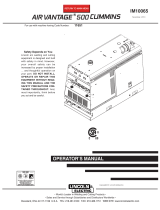
D-1
MAINTENANCE
D-1
MAINTENANCE
General Instructions
1. Blow out the welder and controls with an air hose at
least once every two months. In particularly dirty loca-
tions, this cleaning may be necessary once a week.
Use low pressure air to avoid driving dirt into the insu-
lation.
2. “Current Range Selector” contacts should not be
greased. To keep the contacts clean, rotate the cur-
rent control through its entire range frequently. Good
practice is to turn the handle from maximum to mini-
mum setting twice each morning before starting to
weld.
3. Put a drop of oil on the “Current Range Selector”
shaft at least once every month.
4. When necessary, remove the sediment bowl, if so
equipped, from beneath the fuel tank and clean out
any accumulated dirt and water.
5. Follow the engine service schedule in this manual
and the detailed maintenance and troubleshooting in
the engine manufacturer’s manual.
Cooling System
The Classic 300 D is equipped with a pressure radia-
tor. Keep the radiator cap tight to prevent loss of
coolant. Clean and flush the cooling system periodi-
cally to prevent clogging the passage and overheating
the engine. When antifreeze is needed, always use
the permanent type. Capacity = 9.5 qts (9.0 Ltrs.).
Bearings
This welder is equipped with a double-shielded ball
bearing having sufficient grease to last indefinitely
under normal service. Where the welder is used con-
stantly or in excessively dirty locations, it may be nec-
essary to add one half ounce of grease per year. A
pad of grease one inch wide, one inch long, and one
inch high weighs approximately one half ounce. Over-
greasing is far worse than insufficient greasing.
When greasing the bearings, keep all dirt out of the
area. Wipe the fittings completely clean and use clean
equipment. More bearing failures are caused by dirt
introduced during greasing than from insufficient
grease.
Commutator and Brushes
Uncovered rotating equipment can be dangerous.
Use care so your hands, hair, clothing or tools do
not catch in the rotating parts. Protect yourself
from particles that may be thrown out by the rotat-
ing armature when stoning the commutator.
------------------------------------------------------------------------
Shifting of the commutator brushes may result in:
- Change in machine output
- Commutator damage
- Excessive brush wear
Periodically inspect the commutator, slip rings, and
brushes by removing the covers. DO NOT remove or
replace these covers while the machine is running.
Commutators and slip rings require little attention.
However, if they are black or appear uneven, have
them cleaned by an experienced maintenance man
using fine sandpaper or a commutator stone. Never
use emery cloth or paper for this purpose.
CLASSIC 300D
Have qualified personnel do the maintenance
work. Turn the engine off before working inside
the machine. In some cases, it may be neces-
sary to remove safety guards to perform
required maintenance. Remove guards only
when necessary and replace them when the
maintenance requiring their removal is com-
plete. Always use the greatest care when work-
ing near moving parts.
Do not put your hands near the engine cooling
blower fan. If a problem cannot be corrected by
following the instructions, take the machine to
the nearest Lincoln Field Service Shop.
-----------------------------------------------------------------------
ELECTRIC SHOCK can kill.
• Do not touch electrically live parts or
electrode with skin or wet clothing.
• Insulate yourself from work and
ground
• Always wear dry insulating gloves.
------------------------------------------------------------------------
ENGINE EXHAUST can kill.
• Use in open, well ventilated areas or
vent exhaust outside.
------------------------------------------------------------------------
MOVING PARTS can injure.
• Do not operate with doors open or
guards off.
• Stop engine before servicing.
• Keep away from moving parts.
------------------------------------------------------------------------
See additional warning information at
front of this operator’s manual.
-----------------------------------------------------------
WARNING
WARNING




















